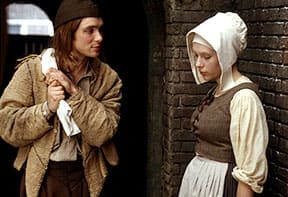Based on a popular novel by Tracy Chevalier, this film is named for the eponymous oil painting by the 17th century Dutch painter Jan Vermeer, and with Girl With a Pearl Earring, director Peter Webber has transposed Chevalier's broadly imagined reverie about the girl in the painting.
An inexperienced servant named Griet, played by Scarlett Johansson, is forced by straightened circumstances to leave her family and go to work in Vermeer's house as a maid. Her youthful beauty and defencelessness create webs of jealousy, intrigue and longing in the cramped and financially stressed Vermeer household.
Johansson plays Griet with a faint and dainty furrow on her lustrous brow. She nicely communicates the bafflement of a very young woman who is becoming aware of the unanswerable question that is the future. Curiosity about the painter's craft, ambivalence about her class-appropriate suitor Pieter and uncertainty about her place in the household stimulate her nascent self-discovery and awareness of new possibilities. I think that some of her befuddlement stems from confusion at being surrounded by a cast of plot devices rather than characters. Griet has dimension because she is defined by multiple relationships and actions. The others seem to exist in a world of socio-political archetypes.
It's painful to watch seasoned actors such as Tom Wilkinson (as Vermeer's patron, Van Ruijven) and Judy Parfitt (the mother-in-law) trying to flesh out roles that serve only to forward the action. The dialogue is liberally dotted with such recyclable plums as, "Don't forget where you came from." The scrupulous production values exhale loudly from the screen at every moment. Seventeenth century Delft is indeed lusciously brought forth, but like the paintings on the easel it all feels more like reproduction than creation. At a copious celebratory feast given at the painter's household, Van Ruijven refers to a particular colour and describes the fantastic source of its pigment in detail. This artistic trivia became general knowledge via another recent and popular book about the origins of artists pigments. The film presents it shamelessly as a bit of arcane fact intended to lend historical authenticity. The same attempt at specificity in character would have helped the actors carry their clothes more convincingly.
At the centre of the film is the relationship that develops between Griet and Vermeer, played by Colin Firth. Vermeer is represented as a man of few words, acknowledged for his genius, yet held in contempt by his wife and her mother for his unwillingness to pay the commercial piper. Indispensable yet misunderstood, he becomes attracted to Griet as he recognises a poetic soul mate, someone who, like himself, stands apart from the world and is awed by it.
How to inject this oft-repeated tale with new life is a fundamental issue. Webber fails either to subvert or enliven the cliché. Firth draws a moody sort of man, silent and inscrutable, but also petulant and scruffy as a rock star. This feels like a modern construction of what we want an artist to be and in general does not sit well with the orderly and devotional quality of the painting.
Firth's Vermeer has married into a continuous line of shrewish women: the Machiavellian powerhouse of his wife's mother, his harridan of a wife, and their daughter, who from her first appearance would not surprise us if her head were to rotate 360 degrees. It's not astonishing that he would gravitate toward the pensive Griet and soon he has upset the entire social order by unofficially enlisting her as an apprentice. She proves her value by shifting an awkward prop from one of his compositions. No one could possibly believe such a fantasy without having been brainwashed by the self-esteem movement.
As tantrums and turbulence ensue, we are offered some relief from the melting minutes of art film pacing. The generous opportunities for visual delectation give us far too much time to recognise that there is not a single interesting intellectual idea to absorb alongside them. Unlike the painting of the girl with the pearl earring, the beautiful surface of this film does not continue to hold attention with the allure of hidden meaning. (Lions Gate)
An inexperienced servant named Griet, played by Scarlett Johansson, is forced by straightened circumstances to leave her family and go to work in Vermeer's house as a maid. Her youthful beauty and defencelessness create webs of jealousy, intrigue and longing in the cramped and financially stressed Vermeer household.
Johansson plays Griet with a faint and dainty furrow on her lustrous brow. She nicely communicates the bafflement of a very young woman who is becoming aware of the unanswerable question that is the future. Curiosity about the painter's craft, ambivalence about her class-appropriate suitor Pieter and uncertainty about her place in the household stimulate her nascent self-discovery and awareness of new possibilities. I think that some of her befuddlement stems from confusion at being surrounded by a cast of plot devices rather than characters. Griet has dimension because she is defined by multiple relationships and actions. The others seem to exist in a world of socio-political archetypes.
It's painful to watch seasoned actors such as Tom Wilkinson (as Vermeer's patron, Van Ruijven) and Judy Parfitt (the mother-in-law) trying to flesh out roles that serve only to forward the action. The dialogue is liberally dotted with such recyclable plums as, "Don't forget where you came from." The scrupulous production values exhale loudly from the screen at every moment. Seventeenth century Delft is indeed lusciously brought forth, but like the paintings on the easel it all feels more like reproduction than creation. At a copious celebratory feast given at the painter's household, Van Ruijven refers to a particular colour and describes the fantastic source of its pigment in detail. This artistic trivia became general knowledge via another recent and popular book about the origins of artists pigments. The film presents it shamelessly as a bit of arcane fact intended to lend historical authenticity. The same attempt at specificity in character would have helped the actors carry their clothes more convincingly.
At the centre of the film is the relationship that develops between Griet and Vermeer, played by Colin Firth. Vermeer is represented as a man of few words, acknowledged for his genius, yet held in contempt by his wife and her mother for his unwillingness to pay the commercial piper. Indispensable yet misunderstood, he becomes attracted to Griet as he recognises a poetic soul mate, someone who, like himself, stands apart from the world and is awed by it.
How to inject this oft-repeated tale with new life is a fundamental issue. Webber fails either to subvert or enliven the cliché. Firth draws a moody sort of man, silent and inscrutable, but also petulant and scruffy as a rock star. This feels like a modern construction of what we want an artist to be and in general does not sit well with the orderly and devotional quality of the painting.
Firth's Vermeer has married into a continuous line of shrewish women: the Machiavellian powerhouse of his wife's mother, his harridan of a wife, and their daughter, who from her first appearance would not surprise us if her head were to rotate 360 degrees. It's not astonishing that he would gravitate toward the pensive Griet and soon he has upset the entire social order by unofficially enlisting her as an apprentice. She proves her value by shifting an awkward prop from one of his compositions. No one could possibly believe such a fantasy without having been brainwashed by the self-esteem movement.
As tantrums and turbulence ensue, we are offered some relief from the melting minutes of art film pacing. The generous opportunities for visual delectation give us far too much time to recognise that there is not a single interesting intellectual idea to absorb alongside them. Unlike the painting of the girl with the pearl earring, the beautiful surface of this film does not continue to hold attention with the allure of hidden meaning. (Lions Gate)




